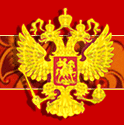 The
Dymkovo settlement near the city of Kirov (formerly known as
Vyatka) is the best known center of earthenware toy production.
The settlement was established in the 15th century by the citizens
of the Northern town of Veliky Ustyug who rebelled against Moscow
domination and were exiled by the Tsar Ivan III to the remote
regions. Some of them including many skilled craftsmen and toy
makers moved to the place that was known as the town of Khlynov
at the time. The
Dymkovo settlement near the city of Kirov (formerly known as
Vyatka) is the best known center of earthenware toy production.
The settlement was established in the 15th century by the citizens
of the Northern town of Veliky Ustyug who rebelled against Moscow
domination and were exiled by the Tsar Ivan III to the remote
regions. Some of them including many skilled craftsmen and toy
makers moved to the place that was known as the town of Khlynov
at the time.
The toys-making trade was primarily promoted by the needs
of the local festival known as the "whistling celebration".
There was a great demand during the festival for various whistles
manufactured by the local craftsmen and shaped as figurines
of birds, horses, and lambs. The festival is rooted in the
pagan worship of Yarilo, the Slavic solar deity. Another ancient
local festival stimulating the demand for toys included all
kinds of popular entertainment such as community contests
for fist fighters and making snowmen. In the 19th century
such rural festivals were quite big affairs, they coincided
with fairs and other trade events and continued for several
days.
The Dymkovo toys were shaped of the local red clay mixed
with fine river sand to prevent cracking during firing. First
the massive base of a toy was shaped and then smaller fragments
were attached to it (chest, arms, head, dress fringes, hair
plaits, or head dresses). The finished toys were dried for
several days, fired for three - four hours, primed with chalk
dissolved in buttermilk, and painted with tempera paints over
the white background. (It was only the Dymkovo toy makers
who "whitened" their products by immersing them
into a suspension of chalk powder in milk.) When the primed
toy was drying in a draught a casein film appeared on the
surface and fixed the chalk coating.
The most ancient motifs of the Dymkovo toys are the animals
and birds. However, the Dymkovo toy trade is famous primarily
for the colorful figurines of proud noble ladies, fat merchant
wives, elegant gentlemen, valiant hussars, and groups of figurines
depicting scenes from the circus life and open-air markets.
The charmingly lively and often funny characters of the toys
graphically represent the everyday life of a small Russian
town in the 19th century.
The toy structure includes basically a bell-shaped skirt
and a torso with attached small spherical head, bent arms,
and diminutive children figures.
The Dymkovo toys are painted in as many as a dozen colors,
rather than two or three, typical for other Russian earthenware
toys. They are adorned with distinctive ornaments of squares,
stripes, circles, loops, or dots. In conclusion a toy is decorated
with diamonds of gold leaf which make it look extremely festive.
|

